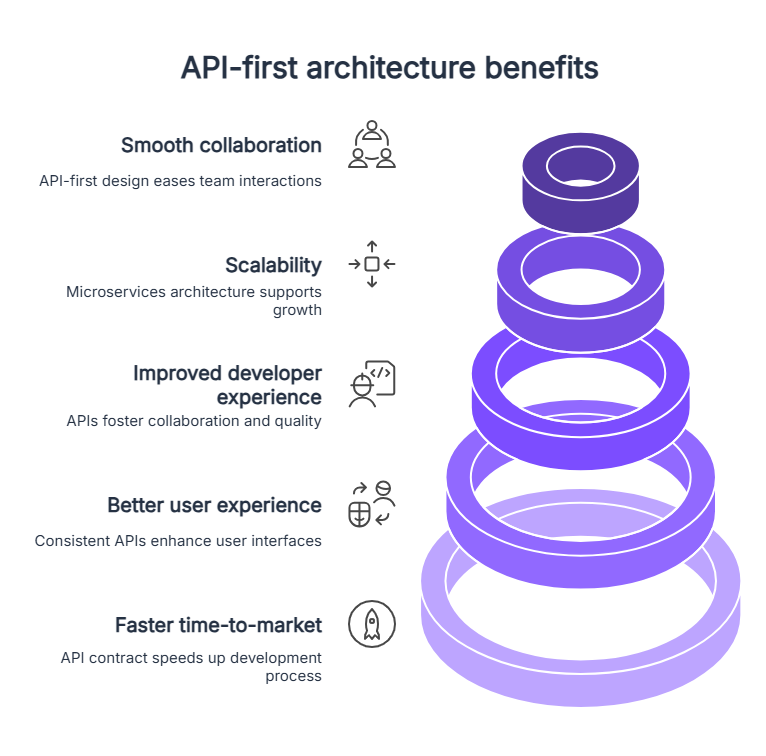Why API-first architecture is the smart choice for enterprises

An API-first approach in software development offers a strategic advantage. This methodology focuses on defining and developing the API contract first, leading to consistent, reusable APIs and improved efficiency throughout the development lifecycle. Benefits include faster time-to-market, enhanced user and developer experiences, scalability and seamless team collaboration. Ideal for designing new applications, API-first design ensures a modern, scalable and flexible architecture. Ready to accelerate your digital transformation?
Companies are constantly finding new ways to innovate products, deliver them to users faster and improve their experience. Having an API-first approach is what helps you meet these goals in business and software development.
This blog will explore the API-first design, how it ensures faster time-to-market and improves user experiences and how you can benefit, too.
What does API-first architecture mean in software development?
An application programming interface (API) is a software intermediary responsible for seamless communication between two applications. APIs have been around almost as long as modern computers and have many purposes.
They can integrate systems and software to support internal workflows and processes at organizations, boosting productivity and collaboration. They can help organizations integrate software with their partner to offer improved or expanded services and experiences to customers. Or they can be shared publicly so they are available to all.
In API-first architecture, designers and developers build the API specification first instead of leaving it as a last step. The first step in the process is to create the API, which ensures that APIs are the same and can be reused by the developers. As a result, developers maintain consistency, efficiency and scalability during the entire development process.
No wonder developers worldwide are adopting this technique to enhance their projects and deliver better user experiences.
Benefits of the API-first architecture
When comparing API-first development with traditional development methodologies, it's clear that the API-first strategy offers a range of advantages. These include the following:
Faster time-to-market
By starting with the API contract up front, development teams don't have to start from scratch when implementing a new feature or service. They can also work on various components of the application simultaneously. All this reduces the overall development lifecycle, enabling businesses to bring their products to market faster.
Better user experience
With an API contract, developers can create consistent, reliable and efficient user interfaces, improving user experiences.
Improved developer experience
A well-documented API fosters better collaboration and understanding among development teams, leading to a smoother developer experience (DX) and higher-quality end products.
Scalability
API-first design is inherently more scalable, as it promotes using microservices architectures, allowing your applications to grow and evolve with ease.
Smooth collaboration
The API-first design helps different teams and stakeholders in a software project. Front-end and back-end developers, UX/UI designers and product managers, to work together with ease.

Real-world scenarios: When to choose an API-enabled vs. API-first strategy
Businesses that already have applications and systems in place can use API-enabled strategies to make them better. An API-first approach is preferred when businesses make and build new applications or systems from scratch. By putting the API at the center of their efforts, you ensure a modern and flexible architecture.
Showcasing successful API-first implementations in leading companies
Companies that use an API-first model have gained increased performance, scalability and new opportunities for growth. Some of them are:
Netflix
By using API first, Netflix ensured that its customers enjoyed the same experience on different devices. Over 2 billion API requests are processed by the company daily, proving how strong its API-first design is.
Slack
Developers built many useful integrations on Slack by using its intuitive APIs. The company’s focus on a developer-first approach has created a loyal customer base and resulted in the rapid growth of the company.
Twilio
Benefiting from an API-centric design, Twilio gives developers the option of seamlessly including voice, messaging and video services within their programs.
Stripe
Stripe's robust and well-documented APIs have made it a global payment gateway that concentrates on offering a hassle-free DX to customers.
The future of API-first development
Industry experts predict that the API-first approach is here to stay, with more and more companies recognizing its potential to expedite development, streamline user experiences and foster innovation.
For instance, Randy Heffner, VP and principal analyst of Forrester Research, said, "API-first is becoming the de facto standard for how leading companies do application development."
As technology evolves, the API-first approach is set to play an even more prominent role in software development. Some predictions for this evolution include:
Increased use of API description languages
Tools like OpenAPI, Postman and Swagger will become essential for teams working with API-first development.
Greater focus on API governance
With the increasing use of APIs, the need for standardized approaches to API management will become more critical.
The rise of microservices architectures
As businesses go from waterfall to agile, the use of microservices will rise, increasing the need for well-designed APIs.
More focus on developer experiences
Companies are likely to focus on ensuring developers have a positive experience by clearly documenting APIs, building communities and assisting developers.
API-first development: How to get started
Should you wish to start taking advantage of API-first strategies, these are the important steps to start:.
Assess your current situation
Analyze the structure of your current processes and application landscape.
Establish your API program
Define a clear API strategy, governance model and goals for your organization, including instituting an API style guide to ensure consistency across APIs.
Assemble an API-first team
Bring together skilled and experienced development teams dedicated to your API-first strategy.
Define your API contract
Create an API specification using an API description language like OpenAPI or RAML (RESTful API Modeling Language).
Implement your API
Follow the API contract to build your API, ensuring it meets the required specifications.
Develop and integrate applications
Encourage your development teams to use the API as the foundation for new applications and update existing applications to utilize the API.
Best practices and actionable insights when adopting an API-first strategy
When taking the above steps, businesses should understand and follow these best practices.
Create a clear API contract
Utilize an API description language like OpenAPI or RAML to create a detailed, comprehensive contract for your API that outlines its functions, inputs, outputs and any authentication requirements.
Develop and maintain a style guide
Having a well-documented style guide in place helps maintain API contract adherence and sets expectations for development teams working with the API. This ensures consistency in design and allows developers to adhere to best practices.
Establish API governance
Implement and document processes to maintain and manage your API program, from version control to access management and performance monitoring.
Prioritize developer tools
Invest in high-quality API documentation, sample code and software development kits (SDKs) to ensure a smooth developer onboarding process.
Embrace a microservices architecture
This architectural pattern promotes modularity, scalability and flexibility, critical elements supporting your API-first approach.
Iterate and improve
Continuous feedback and improvement are cornerstones of successful API-first development. Solicit feedback from users and developers alike to enhance your API over time.
The right platform can fast-track your API-first strategy
API-first is the future of enterprise architecture, and a composable digital experience platform (DXP) like Contentstack can help organizations achieve their API-first goals faster. Contentstack is a headless CMS and supports a modular framework powered by APIs that can integrate with your tech stack to help your organization achieve incredible velocity, expanded capabilities and better customer experiences. However, this approach requires careful planning, technical expertise and the proper support.
Contentstack offers top-notch composable DXP solutions. We offer support during onboarding, professional services and support plans to make sure your team does well with our tools. Our community of experienced developers and partners offers feedback and suggestions, while the Contentstack Academy has extensive online courses and certification tests. Businesses that use Contentstack can achieve the highest agility and flexibility.
Talk to us to know more.
Last update: May 15
About Contentstack
The Contentstack team comprises highly skilled professionals specializing in product marketing, customer acquisition and retention, and digital marketing strategy. With extensive experience holding senior positions at renowned technology companies across Fortune 500, mid-size, and start-up sectors, our team offers impactful solutions based on diverse backgrounds and extensive industry knowledge.
Contentstack is on a mission to deliver the world’s best digital experiences through a fusion of cutting-edge content management, customer data, personalization, and AI technology. Iconic brands, such as AirFrance KLM, ASICS, Burberry, Mattel, Mitsubishi, and Walmart, depend on the platform to rise above the noise in today's crowded digital markets and gain their competitive edge.
In January 2025, Contentstack proudly secured its first-ever position as a Visionary in the 2025 Gartner® Magic Quadrant™ for Digital Experience Platforms (DXP). Further solidifying its prominent standing, Contentstack was recognized as a Leader in the Forrester Research, Inc. March 2025 report, “The Forrester Wave™: Content Management Systems (CMS), Q1 2025.” Contentstack was the only pure headless provider named as a Leader in the report, which evaluated 13 top CMS providers on 19 criteria for current offering and strategy.
Follow Contentstack on LinkedIn.







.svg?format=pjpg&auto=webp)
.svg?format=pjpg&auto=webp)
.png?format=pjpg&auto=webp)






.png?format=pjpg&auto=webp)


